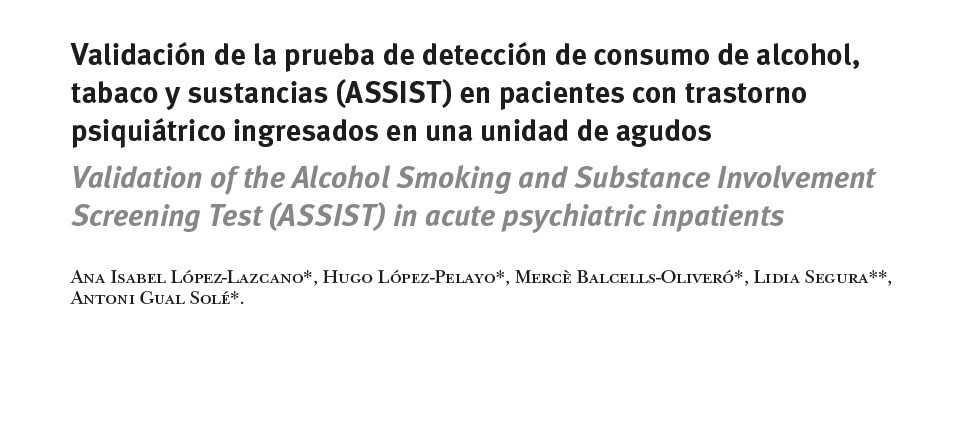RESEARCH SPOTLIGHT

Validation of the Alcohol Smoking and Substance Involvement Screening Test (ASSIST) in acute psychiatric inpatients
Published in: Adicciones (Addictions)
By: López-Lascano, López-Pelayo, Barcells-Oliveró, Segura, and Gual Solé. 2021
WHAT WAS THE STUDY ABOUT?
The aim of this study was to validate the use of ASSIST amongst a cohort of psychiatric inpatients in a Hospital inpatient setting in Cataluña.
WHAT DID THEY DO?
The investigators approached 202 inpatients from a hospital clinic in Barcelona, and asked participants to complete a battery of screening tests, in order to compare the validity and reliability of ASSIST compared to other measures. Specifically, the researchers wanted to validate the ASSIST in psychiatric inpatient settings by comparing individuals’ scores on the ASSIST to other legacy measures, which included: AUDIT, Fagerström Test for Nicotine Dependence (FTND), Severity of dependence scale (SDS) and the Drug Abuse Screening Test (DAST). Scores for total substance involvement (TSI) and substance specific involvement (SSI) were calculated for the ASSIST and compared to the other screening tools, using Exploratory and Confirmatory Factor Analytic methods.
WHAT DID THEY FIND?
This researchers found that, among psychiatric inpatients, ASSIST had adequate capacity to determine substance use risk levels accurately. In simple terms, the ASSIST appeared to group individuals into risk profiles (e.g., low, moderate, high) that were consistent with what would be expected based on scores on the other measures. For example, a person scoring low- moderate- or high-risk on the ASSIST for alcohol, tended to fall in the same category on the AUDIT. This study also showed, as has been shown previously, ASSIST was found to discriminate more effectively between low- and moderate-risk, than between moderate- and high-risk. This is important, as the linked brief intervention is designed, primarily for moderate risk use. A test that is sensitive and capable of identifying cases where an individual’s use may be escalating from low- to more moderate-risk is crucial, because it allows for a greater likelihood of successful early intervention.
Once an individual has progressed to use considered, either moderate- or high-risk, the individual becomes an ideal candidate for brief intervention (plus referral to treatment for high-risk cases), and thus the need to discriminate between moderate and high-risk cases is less important than the need to identify moderate- from low-risk cases.
IN THE AUTHORS WORDS:
“ASSIST scores showed good reliability and there were validity evidences that support its use for identifying risk levels of tobacco, alcohol and other substance use in psychiatric patients… Among the advantages of ASSIST, we can highlight its shorter application time compared to MINI or PRISM, and that, unlike other tests adapted to the psychiatric population, it covers all substances.”
WHAT DO WE LIKE ABOUT THIS RESEARCH?
Currently there are a number of tools and approaches designed to address substance use in clinical settings. While one of the choices that clinicians face involves which test to use, and its interpretation, in general clinicians are still faced with determining the best course of action. The ASSIST however, is designed to expedite this process, by stratifying individuals based on their level of risk, and providing tailored feedback to the individual based on that outcome. The fact that this study was carried out with patients suffering from an acute episode, whose cognitive processes and ability to complete a test could be compromised, shows that it can be applied in hospital settings and in patients suffering not only from a first psychotic episode but also from other mental illnesses.
Currently, individuals working within the mental health sector are in desperate need of resources to deal with the overwhelming public health burden that mental health disorders present. Studies such as these are important because 1) they highlight that there are unstandardized approaches to patient care in certain health settings which require attention; and 2) they also provide evidence and a clear way forward for clinicians in respect to best-practice approaches to screening and brief intervention.
WHAT OPPORTUNITIES DOES THIS RESEARCH PRESENT?
Although this study demonstrated the clinical validity and utility of using the ASSIST as a complete SBIRT framework, there were some limitations that bare mentioning. Primarily, the small number of individuals reporting levels of inhalants and hallucinogens meant limited some of the statistical methods, and therefore more research is needed to calculate sensitivity and specificity for those specific substances/classes.
The crossover between mental health and substance use is substantial. The opportunities to bridge the gap between primary care and mental health settings is becoming increasingly recognized. Starting in early August, we will be running Zoom-based training in SBIRT using the ASSIST for those working in community mental health settings. If this is something that interests you, please stay tuned for updates, so that you can register once training registration is open.
To download our smartphone apps (ASSIST Checkup and ASSIST Checkup Lite), visit the homepage of the ASSIST Portal where you will find the links to the iOS and Android stores
For more information and downloadable resources about the risks and harms of substance in general, as well as handy guidelines on screening and brief intervention, visit our Portal
You can read the full report here (though you’ll need a translator handy)


